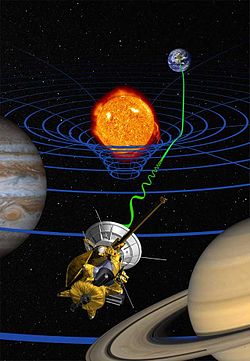
Back مدخل إلى النسبية العامة Arabic Въведение в общата теория на относителността Bulgarian সাধারণ আপেক্ষিকতার ভূমিকা Bengali/Bangla Introducció a la relativitat general Catalan Εισαγωγή στη γενική σχετικότητα Greek Introducción a la relatividad general Spanish آشنایی با نسبیت عام Persian Introduction à la relativité générale French Pengantar relativitas umum ID 一般相対性理論の概説 Japanese

| General relativity |
|---|
 |
General relativity is a theory of gravitation developed by Albert Einstein between 1907 and 1915. The theory of general relativity says that the observed gravitational effect between masses results from their warping of spacetime.
By the beginning of the 20th century, Newton's law of universal gravitation had been accepted for more than two hundred years as a valid description of the gravitational force between masses. In Newton's model, gravity is the result of an attractive force between massive objects. Although even Newton was troubled by the unknown nature of that force, the basic framework was extremely successful at describing motion.
Experiments and observations show that Einstein's description of gravitation accounts for several effects that are unexplained by Newton's law, such as minute anomalies in the orbits of Mercury and other planets. General relativity also predicts novel effects of gravity, such as gravitational waves, gravitational lensing and an effect of gravity on time known as gravitational time dilation. Many of these predictions have been confirmed by experiment or observation, most recently gravitational waves.
General relativity has developed into an essential tool in modern astrophysics. It provides the foundation for the current understanding of black holes, regions of space where the gravitational effect is strong enough that even light cannot escape. Their strong gravity is thought to be responsible for the intense radiation emitted by certain types of astronomical objects (such as active galactic nuclei or microquasars). General relativity is also part of the framework of the standard Big Bang model of cosmology.
Although general relativity is not the only relativistic theory of gravity, it is the simplest one that is consistent with the experimental data. Nevertheless, a number of open questions remain, the most fundamental of which is how general relativity can be reconciled with the laws of quantum physics to produce a complete and self-consistent theory of quantum gravity.
© MMXXIII Rich X Search. We shall prevail. All rights reserved. Rich X Search
